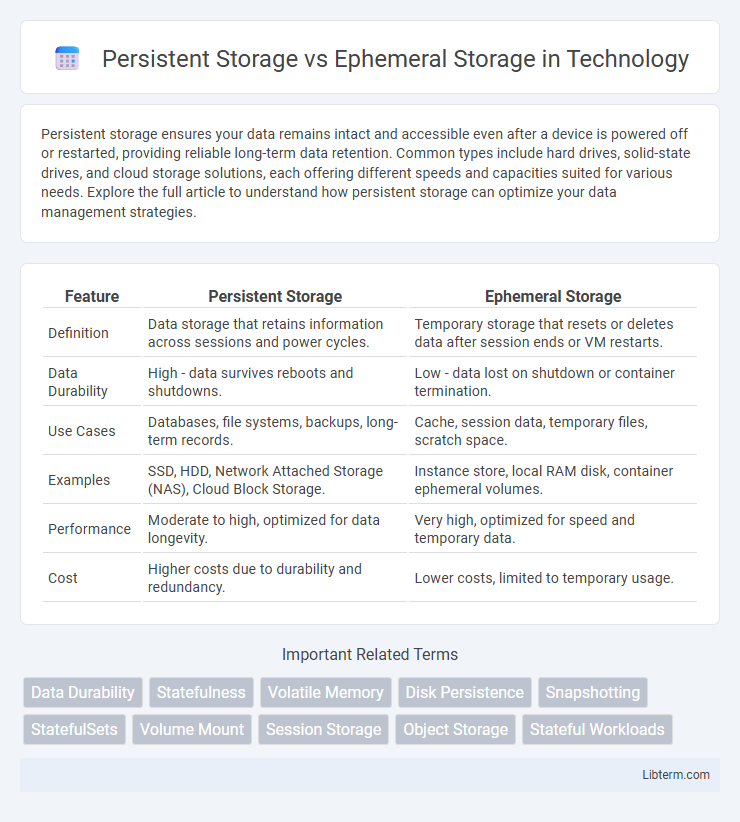Persistent storage ensures your data remains intact and accessible even after a device is powered off or restarted, providing reliable long-term data retention. Common types include hard drives, solid-state drives, and cloud storage solutions, each offering different speeds and capacities suited for various needs. Explore the full article to understand how persistent storage can optimize your data management strategies.
Table of Comparison
| Feature | Persistent Storage | Ephemeral Storage |
|---|---|---|
| Definition | Data storage that retains information across sessions and power cycles. | Temporary storage that resets or deletes data after session ends or VM restarts. |
| Data Durability | High - data survives reboots and shutdowns. | Low - data lost on shutdown or container termination. |
| Use Cases | Databases, file systems, backups, long-term records. | Cache, session data, temporary files, scratch space. |
| Examples | SSD, HDD, Network Attached Storage (NAS), Cloud Block Storage. | Instance store, local RAM disk, container ephemeral volumes. |
| Performance | Moderate to high, optimized for data longevity. | Very high, optimized for speed and temporary data. |
| Cost | Higher costs due to durability and redundancy. | Lower costs, limited to temporary usage. |
Introduction to Data Storage Types
Persistent storage refers to data storage that retains information even when the power is turned off, making it essential for long-term data preservation in devices like hard drives, SSDs, and cloud storage systems. Ephemeral storage, in contrast, temporarily holds data during active sessions and loses all contents once the system powers down or the session ends, commonly used in RAM or temporary caches. Understanding the distinction between persistent and ephemeral storage is crucial for optimizing data management strategies in computing environments.
Defining Persistent Storage
Persistent storage refers to data storage that retains information even after power loss or system shutdown, ensuring long-term data availability and reliability. It is commonly implemented through devices like hard drives, solid-state drives (SSDs), and cloud storage solutions, which provide non-volatile memory for databases, applications, and operating systems. Unlike ephemeral storage, persistent storage enables data durability, backup, and recovery, making it essential for critical business operations and compliance requirements.
Understanding Ephemeral Storage
Ephemeral storage refers to temporary storage that exists only during the lifecycle of a specific instance or container and is deleted once the instance is terminated or restarted. It is commonly used for caching, temporary data processing, and session storage in cloud environments where high-speed, short-lived storage is needed without the overhead of persistent backup. Understanding ephemeral storage is crucial for designing architectures that separate transient data from critical, durable data stored in persistent storage solutions like block storage, object storage, or databases.
Key Differences Between Persistent and Ephemeral Storage
Persistent storage retains data permanently, allowing information to survive system reboots and power failures, while ephemeral storage stores data temporarily and is lost once the system or application shuts down. Persistent storage is often used for databases, file servers, and cloud storage solutions, ensuring durability and availability. In contrast, ephemeral storage is suited for caching, session data, and temporary processing where long-term data retention is unnecessary.
Use Cases for Persistent Storage
Persistent storage is ideal for applications requiring data durability, such as databases, content management systems, and financial transaction records, where data must be retained beyond the lifespan of individual compute instances. It supports backup and disaster recovery strategies by preserving data through container restarts and system failures. Use cases include cloud-based file storage, stateful application data, and long-term archival storage in environments like Kubernetes persistent volumes and Amazon EBS.
Use Cases for Ephemeral Storage
Ephemeral storage is ideal for temporary data handling in cloud environments, such as caching, session data, or intermediate processing files that do not require long-term persistence. Use cases include running containerized applications with transient state, batch processing jobs that generate temporary outputs, and distributed systems that need fast read/write access without the overhead of durable storage. Its fast I/O access and cost-effectiveness make ephemeral storage suitable for scenarios where data persistence and durability are not essential.
Performance Implications
Persistent storage typically offers higher latency due to data durability requirements and complex I/O operations, impacting application response times compared to ephemeral storage. Ephemeral storage provides faster read/write speeds and lower latency by leveraging temporary, in-memory or local disk resources, enhancing performance for transient data processing. However, persistent storage ensures data consistency and reliability essential for long-term data access, while ephemeral storage optimizes speed at the cost of data volatility.
Security Considerations
Persistent storage offers enhanced security through data encryption at rest and comprehensive backup strategies, ensuring long-term data integrity and compliance with regulatory standards. Ephemeral storage, by design, reduces the attack surface by automatically deleting data after use, minimizing risks of data leakage or unauthorized access. Implementing strict access controls and secure key management is critical for both storage types to prevent data breaches and maintain data confidentiality.
Cost Comparison
Persistent storage typically incurs higher costs due to its long-term data retention, redundancy, and backup features, making it suitable for critical data requiring durability. Ephemeral storage is generally more cost-effective for temporary data since it offers lower prices by sacrificing data persistence and reliability after instance termination. Evaluating cost-efficiency depends on application requirements, with persistent storage favored for durability and ephemeral storage preferred for transient workload savings.
Choosing the Right Storage for Your Application
When choosing the right storage for your application, consider that persistent storage retains data across sessions, making it ideal for databases, logs, and user-generated content requiring durability. Ephemeral storage offers fast, temporary data storage suited for caching, session data, or intermediate computations that do not require long-term retention. Match storage type to data lifecycle, performance needs, and recovery requirements to optimize application efficiency and reliability.
Persistent Storage Infographic

 libterm.com
libterm.com